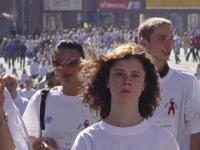
Members of the public take part in "Race for life" in Kiev, Ukraine. With an adult HIV prevalence of 1.6% in 2007, Ukraine has the largest HIV prevalence in Europe. Credit: UNAIDS
An estimated 1.5 million adults and children are living with HIV in Eastern Europe and Central Asia. With an adult HIV prevalence of 1.6% in 2007, Ukraine has the largest prevalence in all of Europe. Estonia, Russian Federation and Ukraine all have HIV prevalence that exceeds 1%.
Experts are concerned that the epidemic continues to outpace the response.
It’s essential to have much more aggressive prevention in the region. HIV prevention makes sense for human society, both economically and strategically.
Dr Denis Broun, Director of UNAIDS Regional Support Team for Europe and Central Asia
“There has been a dramatic increase in the estimated number of people living with HIV in the Eastern Europe and Central Asia region since 2001, an increase of as much as 66%,” said Dr Denis Broun, Director of UNAIDS Regional Support Team for Europe and Central Asia.”Conversely, during the same period, HIV prevalence decreased by 5% in Asia, " he continued.
There have been improvements in the region including a growth in access to HIV treatment services leading to lowering mortality from AIDS. Also there has been an increase in prevention of mother-to-child HIV transmission services which are helping to reduce the number of babies born with HIV. Community participation in the AIDS response has been strengthened with progressively more meaningful involvement of people living with HIV, civil society and religious organizations.
Prevention services for those most-at-risk
Given that injecting drug use is the major mode of HIV transmission across Eastern Europe and Central Asia, HIV prevention among drug users and their sexual partners should be a vital component of AIDS responses in the region. However HIV prevention services, and in particular prevention work among vulnerable groups and young people have not been scaled-up with the rising numbers of infections.
“It’s essential to have much more aggressive prevention in the region. HIV prevention makes sense for human society, both economically and strategically,” said Dr Broun.
Regional leadership in CIS

(from left) Dr Denis Broun, Director of UNAIDS Regional Support Team for Europe and Central Asia; Georgiy Narushevich, the Adviser to the CIS Executive Committee. Credit: UNAIDS
A major step towards a more strategic AIDS response was achieved at the expanded meeting of the Commonwealth of Independent States (CIS) Coordination Council on HIV/AIDS which took place recently in Moscow
Representatives of ten member states of the CIS with participation of community of people living with HIV in the region, discussed actions for the implementation of the 2009-2013 CIS Programme of Joint Actions on HIV/AIDS.
This Programme was approved by the Council of the CIS Heads of Government last November. It will facilitate the introduction and practice of fundamental principles in the HIV response in CIS countries. For example, to improve coordination within countries via a single national AIDS programme, with one coordinating body and one agreed country-level monitoring and evaluation system.
Also, to turn the tide of the epidemic, other strategies were identified such as providing access to free, voluntary and confidential HIV counseling and testing and national prevention programmes to reach young people and key populations at higher risk.
A dialogue about and reporting on the implementation of the Programme of Joint Actions will continue with UNAIDS with ongoing support offered online and at regular working groups meeting.

Expanded meeting of the Commonwealth of Independent States Coordination Council on HIV/AIDS. Moscow, 25-26 February, 2010.
Credit: UNAIDS
The discussion took place against the backdrop of reviewing the progress in achievement of Universal Access targets by 2010. Participants also outlined the urgent measures to be taken to accelerate progress. This meeting of the CIS Coordination Council on HIV/AIDS was an opportunity to review progress and challenges in scaling up universal access to HIV prevention, treatment, prevention, care and support.
“We reached a consensus on the priority measures for implementation of the Programme of joint actions at the meeting,” Georgiy Narushkevich, the Adviser to the CIS Executive Committee commented.
“That’s a major achievement in consolidation of the HIV response at the high political level.”





 (from left) Dr Denis Broun, Director of UNAIDS Regional Support Team for Europe and Central Asia; Georgiy Narushevich, the Adviser to the CIS Executive Committee. Credit: UNAIDS
(from left) Dr Denis Broun, Director of UNAIDS Regional Support Team for Europe and Central Asia; Georgiy Narushevich, the Adviser to the CIS Executive Committee. Credit: UNAIDS Expanded meeting of the Commonwealth of Independent States Coordination Council on HIV/AIDS. Moscow, 25-26 February, 2010.
Expanded meeting of the Commonwealth of Independent States Coordination Council on HIV/AIDS. Moscow, 25-26 February, 2010.